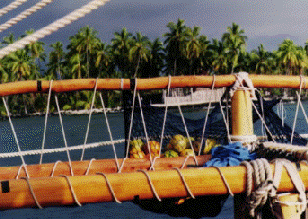Provisions for a Modern Voyage on Hōkūle‘a (1992)

Oranges for the Crew / Honaunau, 1992
Like an ancient voyaging canoe, Hōkūle‘a is relatively a self-contained environment. It has to take with it what the crew needs to survive for the number of days at sea, though food and water can be supplemented by fish and rain caught during the voyage.
The canoe has a displacement of about 12.5 tons (25,000 pounds). It weighs 7 tons (14,000 pounds) with its rigging, so it can carry an additional 5.5 tons (11,000 pounds)-which includes the weight of the crew, as well as the weight of provisions, supplies, and personal gear.
Food consists mainly of canned, packaged, and dried foods, and weighs about a ton. On a long voyage, about one-and-a-half tons of water are stored in five-gallon plastic jugs. The crew eats three meals and is allotted one quart of water per day. During the voyage, the captain monitors how much is being consumed. If the voyage is taking longer than expected because of unfavorable winds, the food and water are rationed. However, dehydration can be a problem in hot, humid weather, so water has been rationed. This was done only twice in the history of Hokule'a voyaging. Rainfall, caught in tarps, helps replenish the water supply.
The quartermaster must distribute the weight of the supplies in the two hulls and be careful not to overload the canoe because overloading would reduce the canoe's manuveurability and increase the possibility of swamping. On the 1992 voyage, quartermaster Harry Ho and the captains supervised the provisioning and loading of the canoe.
On its 1992 voyage from Hawai'i to Tahiti, which was estimated to take about 30 days, the canoe left with a crew of 13 (twelve men and one woman) and about 35-40 days of food and water.
Provisions and supplies for the canoe included the following:
1.75 tons (3,500 pounds) of water (or about 407 gallons in 81 five-gallon containers; water weighs 8.6 pounds per gallon);
One ton (2,000 pounds) of food
Galley Equipment (e.g., propane gas stove, pots and pans, kitchen utensils, dishes)
Safety Equipment (e.g. life preservers, safety harnesses, safety nets, fire extinguishers, man-overboard float with pole, surfboard, anchors, portable hand-operated bilge-pumps, foul-weather gear, waterproof flashlights
Global Positioning System (GPS) unit to give the crew the position of the canoe in an emergency; ARGOS transponder to send position back to UH Manoa; EPIRB to send out emergency position reports)
Communication Equipment, powered by two 12-volt marine batteries and three solar energy panels mounted at the back of the canoe (VHF radio and antennae for short-range communication; single-side band radio for long-range communication.
Optional: Inmarsat-C equipment which can transmit GPS position reports via satellite back to Hawai'i [these position reports are sent automatically and without the crew's knowledge whenever the computer is turned on and every 10 minutes thereafter.
Documentation Equipment (e.g., pens and tablets, tape recorders, video camera, camera)
Medical Supplies (See "Medical Needs"; a medical officer is included as a member of each crew.)
Various Sizes of Sails and Extra Ropes and Lines
Tools (e.g. screwdrivers, hammers, hand saws, planes, pliers, wrenches, files, clamps)
Recommended personal gear for each crew member includes such items as: a passport, a driver's license, medical card, knife with fid, dark glasses with tether, hat or head protection, small flashlight, extra batteries, roll of small line, ball of wax, roll of duck tape, log book and writing implements, camera and film, poncho liner or light sleeping bag, as well as toiletries (sun screen and lip balm, towels and wash cloth, sea soap, shampoo, tooth brush and paste, dental floss, razor, a small mirror, toilet paper and sanitary napkins, etc.). For passing the time, paperbacks, a star book, and a walkman and tapes are permitted; no radios are allowed as they can be used to locate the direction of land (by turning the radio in different directions to find the direction of a radio signal) or to hear reports of the canoe's location. Mask, fins, and snorkel are optional. Each crew member packs his or her gear in a 48 qt. cooler and a small duffle bag, with a hip pack and gear hammock for carrying or hanging things.
